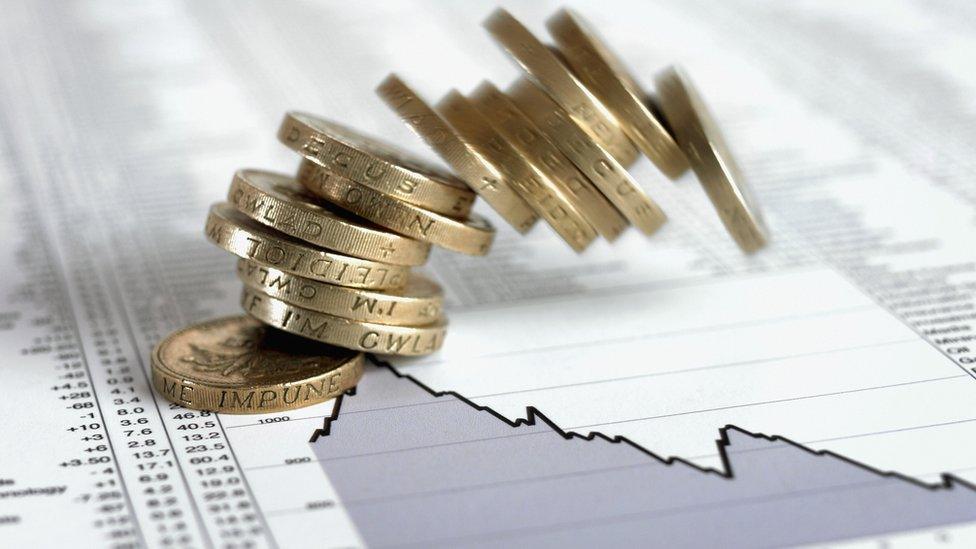NI Rates: How much will your household rates increase by?
- Published
- comments

Refuse collections are among services funded by councils
All of Northern Ireland's councils have reported their rates increases for the next year.
Mid and East Antrim has the highest uplift, of 9.78%, while Lisburn and Castlereagh is the lowest, at 3.98%.
Rates in Northern Ireland pay for public services and projects.
The council fees come in the form of domestic and non-domestic rates while there is a regional rate set by Stormont.
By Wednesday evening, all councils in Northern Ireland had announced the rises ratepayers will face for the coming year.

Mid and East Antrim is the highest increase, while the lowest was agreed by Lisburn and Castlereagh Council, at 3.98%.
Rates in Northern Ireland pay for public services and projects.
Bills are calculated on property value using what is known as the district rate and the regional rate. Councils set the district rate.
Last year, five of the 11 local authority areas agreed rates increases of more than 7%.
This size of annual increase had only been seen once before - in 2020 in Causeway Coast and Glens - since the reform of local government in 2015 to create 11 larger councils.

What are the different types of rates?
Households in Northern Ireland pay different kinds of rates than businesses, they are known as domestic rates.
Your domestic rates bill is made up of two parts - the first is the district rate which is set by each of the 11 councils.
That is what has been agreed so far.
However, the other part of your rates bill will be determined by the regional rate which is set by Stormont.
We do not know yet at what level that will be set.
Yesterday, the First Minister Michelle O'Neill ruled out a 15% increase in the regional rate.
However, that does not rule out an increase at all.
If it were to rise in line with inflation, that would mean an increase of 4%.

Below, BBC News NI examines the rates situation in each council area.

Antrim and Newtownabbey
Antrim and Newtownabbey Borough Council have applied an increase of 4.97% to the district rates.
This equates to an increase of £22 per year for an average household.
The mayor, Cllr Mark Cooper said the council had "worked tirelessly to maintain and deliver a low increase to the rates".
"An increase of 4.97% highlights the council's efforts to provide high quality and efficient services while ensuring a thriving and resilient future for the borough," he added.

Ards and North Down
Ards and North Down Borough Council has agreed an increase of 5.98% to its district rate for 2024-25.
It amounts to an average increase of £2.75 each month for the average household and an average of £25 per business.
The hike was approved unanimously by councillors.

Armagh, Banbridge and Craigavon
ABC Council has agreed to increase household rates by 5.17%.
Prior to last year's rise of 5.96%, the council area had never increased annually by more than 2.95%.
Lord Mayor Ald Margaret Tinsley said: "The council has carefully and rigorously agreed a rate that balances priorities despite external financial challenges and ensures vital public services are delivered while further investment in our communities, towns and villages continue."
She added that the budget will "drive economic growth, deliver on a programme of capital investment and keep the burden on our ratepayers to an absolute minimum."

Belfast City
Belfast City Council has agreed to increase household rates by 5.44%.
Prior to last year's 7.99% rise, councillors had never previously agreed to an annual increase higher than 2.99%.
Cllr Tina Black, chair of the council's strategic policy and resources committee. said that all parties had "worked hard to keep this year's rise as low as possible".
She said the council had been impacted by the cost-of-living crisis and the rising costs of energy and services but added this rise allows the council to "support our council workers with fair pay and also invest in improvements which will make a real difference to citizens".

Causeway Coast and Glens
Councillors have agreed an increase of 6.86% for householders from 1 April - this follows a rise of 7.95% last year.
Mayor Steven Callaghan said the council faced "significant financial pressures" including utility costs, increased insurance costs and high levels of inflation, all of which are putting "considerable strain on revenue".
He added: "Elected members have worked closely with council officers to agree a rate that will minimise the financial burden on householders and businesses, while balancing the need to maintain our excellent frontline operations and ensure continued investment in our services and infrastructure going forward."

Derry and Strabane
District rates will increase by 6.5% in Derry and Strabane District Council.
The body said while financial challenges were not as significant as last year, issues such as high inflation, staff pay and cost of living pressures were among the factors leading to the rise.
"Members in approving the agreed district rates increase will allow council to continue to press ahead with its ambitious plans to drive growth and investment across the city and region as well deliver critical front-line services across the city and district," a statement on the council's website said.
The SDLP's group leader, Brian Tierney, said his party could not back a rise which he said would "punish the worst off in our city and district".

Fermanagh and Omagh
Fermanagh and Omagh District Council voted for a 4.72% rise.
This follows a 5.59% rise last year in a council which had never previously agreed an annual increase of more than 3%.
Independent Cllr Josephine Deehan told members: "I'm not for one moment dismissing the concerns expressed regarding the potential impact on ratepayers, and we are acutely aware of the cost-of-living crisis.
"It's not an ideal situation, to increase rates by any amount, but if we are to square the circle, we have to accept some rise is unavoidable."

Lisburn and Castlereagh
The council agreed a 3.98% increase from last year's rates for the district.
This follows a record annual rise of 7.94% last year.
Ald Owen Gawith, chair of the council's corporate services committee said: "These are difficult times, not least because of the cost-of-living crisis so many are facing.
"Many of the financial pressures experienced by our ratepayers also affect us as a council.
"Despite this, we have focused on ensuring that our proposed rate increase is as low as possible for both domestic and non-domestic properties, and below the 4% level of inflation."

Mid and East Antrim
Average bills will rise by £72.03 a year in Mid and East Antrim after a rates increase of 9.78% was agreed.
Prior to last year's 5.43% rise, the council had never increased rates by more than 3.7% since its formation in 2015.
A council spokesperson said: "We are acutely aware of the struggles many people and our businesses are facing within our community and remain focused on doing everything within our power to help and support them, while safeguarding the essential services they rely on."
Councillors were divided on the rise as 20 voted for and 14 against.
Backing the increase, DUP Ald William McCaughey said no councillor would be "overjoyed" by the hike, "but if we are to support our community groups and fund events, then we must set appropriate rates to do so".

Mid Ulster
Mid Ulster District Council has agreed to increase household rates by 5.9%, following on from a rise of 7.3% last year.
A council spokesperson said that "against a history of keeping district rate increases among the lowest in the region for many years" setting a budget that minimised the impact on the public had been "extremely difficult".
The council cited a difficult financial climate, high inflation, rising global costs of energy and a shortfall in central government funding received by the council through the rates support grant.

Newry, Mourne and Down
In the Newry, Mourne and Down district, householders face a rates hike of 6.41%.
This is even more than the increase of 5.99% agreed by the council last year.
The council's chairperson, Cllr Valerie Harte, said this year's rates increase reflected the "continuing economic challenges" the authority was facing.
"In setting the rate, the council must strike a balance recognising the challenging financial and economic situation and the need to continue to invest in our services and communities," she added.

Related topics
- Lisburn and Castlereagh City Council
- Belfast City Council
- Armagh City, Banbridge and Craigavon Borough Council
- Antrim and Newtownabbey Borough Council
- Mid Ulster District Council
- Causeway Coast and Glens Borough Council
- Derry City and Strabane District Council
- Fermanagh and Omagh District Council
- Mid and East Antrim Borough Council
- Ards and North Down Borough Council
- Local government
- Newry City, Mourne and Down District Council
- Published18 February 2023

- Published18 January 2023

- Published17 February 2022
